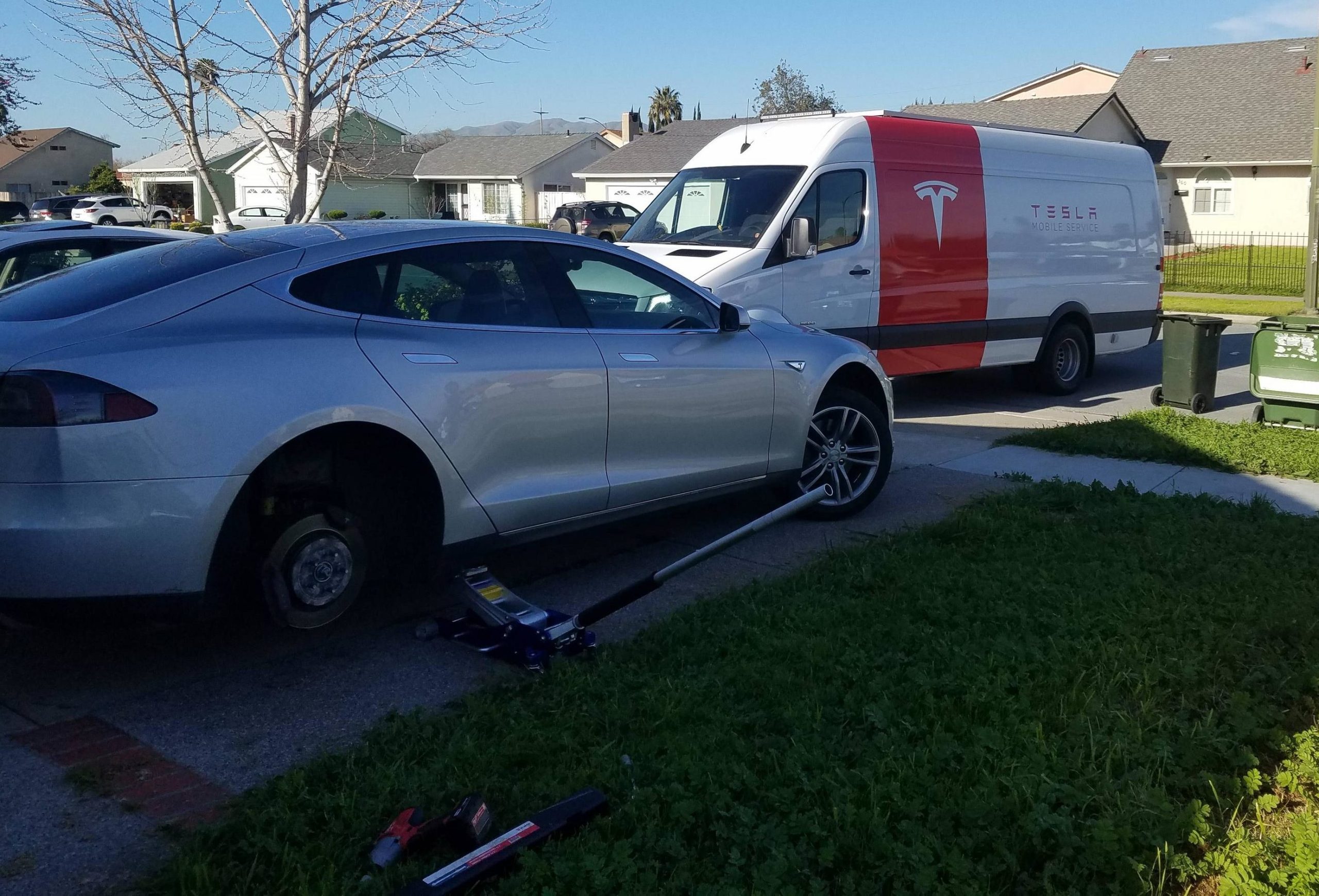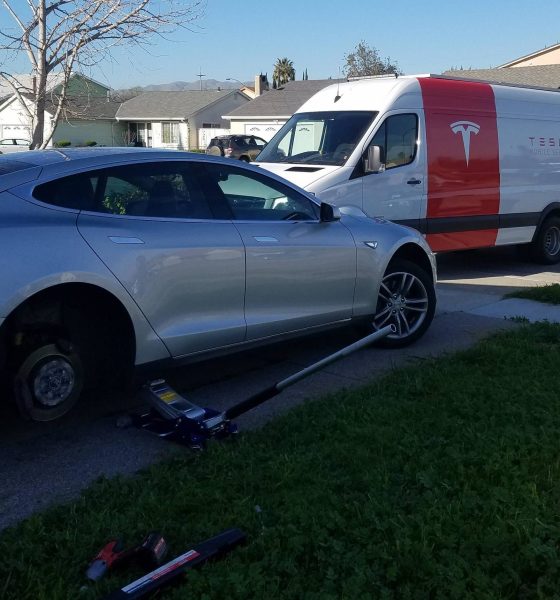

News
Tesla owners can soon request service from their mobile app, says Elon Musk
Shortly before Elon Musk revealed the long-awaited specifications and pricing for the Tesla Model 3 Dual Motor AWD version, Tesla’s CEO noted that owners would soon be able to request service through their smartphones. Musk further added that the use of the mobile-based service would require no paperwork on the part of the electric cars’ owners.
While the updated mobile repair system would cost the company more, the higher cost of the upcoming smartphone-based service will result in better “owner happiness,” making the system “worth doing.” Musk further added that Tesla owners who hear rattles or squeaks in their vehicles would be able to use their smartphones as a means for the company to pinpoint the source of the sounds. Such a process, according to Musk, would be accomplished through acoustic signature and triangulation.
We’re working on allowing you to use your phone in car when you hear a rattle/squeak & pinpoint origin by acoustic signature & triangulation
— Elon Musk (@elonmusk) May 21, 2018
As could be seen in Tesla’s support page, roadside assistance services are offered to Tesla owners as a means to “minimize inconvenience” when vehicles become inoperable. Roadside assistance is available for Tesla owners during the first four years or the 50,000 miles covered by the New Vehicle Warranty for the Model S, Model X, and Model 3. Roadside assistance is also provided under the Battery and Drive Unit Limited Warranty.
Some areas of the United States include assistance for flat tires as well. As we noted in a previous report, Tesla’s Mobile Tire Service program was launched by the electric car maker to respond to owners who end up with a flat tire. A Tesla owner who tried out the service noted that the mobile service team responded to a request within 20 minutes. The entire repair service, from flat to back-again-on-the-freeway, was completed in one hour.
Elon Musk’s tweetstorm on Saturday came as he was releasing information about the Model 3’s dual-motor AWD and Performance versions. Musk dropped several new pieces of information during his Twitter session, from the electric cars’ use of a hybrid AC induction and partial, permanent magnet electric motors and the vehicles’ white interior. Musk also provided the price and performance figures of the dual-motor AWD Performance Model 3.
Tesla has been consistent in its efforts to improve owners’ service experience. Over the past year alone, Tesla has launched several programs aimed at making repairs easier and more manageable for the company’s consumer base. During Tesla’s Q1 2017 earnings update, Elon Musk stated that the top-tier P100D variants of the Model S and Model X will be used as loaners for owners whose vehicles are in for maintenance and repairs. According to Musk, Tesla’s goal is to make a “kind of thing where (owners will) hope service takes a long time because (they) have the absolute top-of-the-line (vehicle) as a service loaner.”
Prior to the start of the Model 3’s mass production last July, Tesla also opted to add 350 more service vans to help service its ever-growing fleet. On December, Tesla launched a service that allows owners to book a service appointment online without needing to call or email the company.

News
Tesla FSD fleet is nearing 7 billion total miles, including 2.5 billion city miles
As can be seen on Tesla’s official FSD webpage, vehicles equipped with the system have now navigated over 6.99 billion miles.

Tesla’s Full Self-Driving (Supervised) fleet is closing in on almost 7 billion total miles driven, as per data posted by the company on its official FSD webpage.
These figures hint at the massive scale of data fueling Tesla’s rapid FSD improvements, which have been quite notable as of late.
FSD mileage milestones
As can be seen on Tesla’s official FSD webpage, vehicles equipped with the system have now navigated over 6.99 billion miles. Tesla owner and avid FSD tester Whole Mars Catalog also shared a screenshot indicating that from the nearly 7 billion miles traveled by the FSD fleet, more than 2.5 billion miles were driven inside cities.
City miles are particularly valuable for complex urban scenarios like unprotected turns, pedestrian interactions, and traffic lights. This is also the difference-maker for FSD, as only complex solutions, such as Waymo’s self-driving taxis, operate similarly on inner-city streets. And even then, incidents such as the San Francisco blackouts have proven challenging for sensor-rich vehicles like Waymos.
Tesla’s data edge
Tesla has a number of advantages in the autonomous vehicle sector, one of which is the size of its fleet and the number of vehicles training FSD on real-world roads. Tesla’s nearly 7 billion FSD miles then allow the company to roll out updates that make its vehicles behave like they are being driven by experienced drivers, even if they are operating on their own.
So notable are Tesla’s improvements to FSD that NVIDIA Director of Robotics Jim Fan, after experiencing FSD v14, noted that the system is the first AI that passes what he described as a “Physical Turing Test.”
“Despite knowing exactly how robot learning works, I still find it magical watching the steering wheel turn by itself. First it feels surreal, next it becomes routine. Then, like the smartphone, taking it away actively hurts. This is how humanity gets rewired and glued to god-like technologies,” Fan wrote in a post on X.
News
Tesla starts showing how FSD will change lives in Europe
Local officials tested the system on narrow country roads and were impressed by FSD’s smooth, human-like driving, with some calling the service a game-changer for everyday life in areas that are far from urban centers.

Tesla has launched Europe’s first public shuttle service using Full Self-Driving (Supervised) in the rural Eifelkreis Bitburg-Prüm region of Germany, demonstrating how the technology can restore independence and mobility for people who struggle with limited transport options.
Local officials tested the system on narrow country roads and were impressed by FSD’s smooth, human-like driving, with some calling the service a game-changer for everyday life in areas that are far from urban centers.
Officials see real impact on rural residents
Arzfeld Mayor Johannes Kuhl and District Administrator Andreas Kruppert personally tested the Tesla shuttle service. This allowed them to see just how well FSD navigated winding lanes and rural roads confidently. Kruppert said, “Autonomous driving sounds like science fiction to many, but we simply see here that it works totally well in rural regions too.” Kuhl, for his part, also noted that FSD “feels like a very experienced driver.”
The pilot complements the area’s “Citizen Bus” program, which provides on-demand rides for elderly residents who can no longer drive themselves. Tesla Europe shared a video of a demonstration of the service, highlighting how FSD gives people their freedom back, even in places where public transport is not as prevalent.
What the Ministry for Economic Affairs and Transport says
Rhineland-Palatinate’s Minister Daniela Schmitt supported the project, praising the collaboration that made this “first of its kind in Europe” possible. As per the ministry, the rural rollout for the service shows FSD’s potential beyond major cities, and it delivers tangible benefits like grocery runs, doctor visits, and social connections for isolated residents.
“Reliable and flexible mobility is especially vital in rural areas. With the launch of a shuttle service using self-driving vehicles (FSD supervised) by Tesla in the Eifelkreis Bitburg-Prüm, an innovative pilot project is now getting underway that complements local community bus services. It is the first project of its kind in Europe.
“The result is a real gain for rural mobility: greater accessibility, more flexibility and tangible benefits for everyday life. A strong signal for innovation, cooperation and future-oriented mobility beyond urban centers,” the ministry wrote in a LinkedIn post.
News
Tesla China quietly posts Robotaxi-related job listing
Tesla China is currently seeking a Low Voltage Electrical Engineer to work on circuit board design for the company’s autonomous vehicles.

Tesla has posted a new job listing in Shanghai explicitly tied to its Robotaxi program, fueling speculation that the company is preparing to launch its dedicated autonomous ride-hailing service in China.
As noted in the listing, Tesla China is currently seeking a Low Voltage Electrical Engineer to work on circuit board design for the company’s autonomous vehicles.
Robotaxi-specific role
The listing, which was shared on social media platform X by industry watcher @tslaming, suggested that Tesla China is looking to fill the role urgently. The job listing itself specifically mentions that the person hired for the role will be working on the Low Voltage Hardware team, which would design the circuit boards that would serve as the nervous system of the Robotaxi.
Key tasks for the role, as indicated in the job listing, include collaboration with PCB layout, firmware, mechanical, program management, and validation teams, among other responsibilities. The role is based in Shanghai.
China Robotaxi launch
China represents a massive potential market for robotaxis, with its dense urban centers and supportive policies in select cities. Tesla has limited permission to roll out FSD in the country, though despite this, its vehicles have been hailed as among the best in the market when it comes to autonomous features. So far, at least, it appears that China supports Tesla’s FSD and Robotaxi rollout.
This was hinted at in November, when Tesla brought the Cybercab to the 8th China International Import Expo (CIIE) in Shanghai, marking the first time that the autonomous two-seater was brought to the Asia-Pacific region. The vehicle, despite not having a release date in China, received a significant amount of interest among the event’s attendees.








